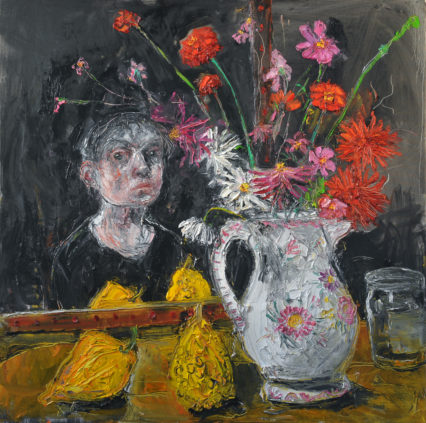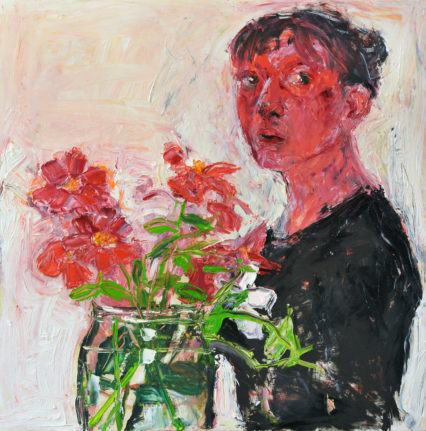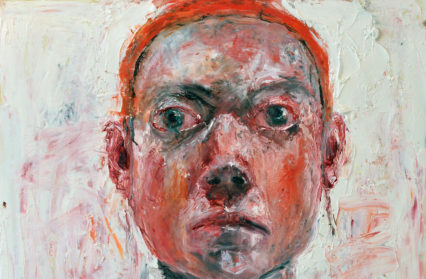Nigel Jarrett travels to London to review the first solo exhibition, This Inconstant State, from Shani Rhys James since her residency in New York in 2015.
Shani Rhys James is not alone among artists in exploring a single corner of human existence time and again. Predominantly domestic, her niche also resonates outwards and inwards with unspecified anxiety; not that everyone requires explication or that, in being non-specific, it’s a state with which the viewer cannot sympathise. In many ways her work is serial self-portraiture, in which a variation of narcissism wrestles with deep and chronic unease. Her milieu appears to have the sub-text of a Paula Rego and, sometimes, the indulgence of a Bonnard, though in the latter, and at the practical level, mainly with a less subtle palette. The Rego-style inside story seems to be less savage, and the gratification is to do with applying and manipulating paint. That’s the point at which one seeks to place her in the movements and trends of contemporary art.

The term ‘easel-painting’, which is what she does, has long been pejorative usage, even when applied to abstraction. Jettisoning of traditional materials and techniques and the ability to draw an anatomically-correct figure – nay, drawing itself – have long been considered unimportant or irrelevant. Art can be made without them; indeed, their very influence has been considered pernicious by some for fifty years. Have we moved on? Well, we’ve moved. Art history, like the history of almost anything else creative today, is now stellar, not linear. Because it’s new doesn’t mean it’s better. But instead of rejoicing at variety, we cavil at departures, as the American critic Clement Greenberg did when Pop Art arrived to sully the high altar of Abstractionism. Only someone who viewed development as exclusively progress could have called Pop a betrayal. The problem with a firmament, though, is that some stars shine more brightly than others. In what constellation does Rhys James orbit and sparkle, and with what degree of luminosity?
Having prepared us with a series of decisive personal moments narrowly circumscribed – she emigrated to Britain as a child from Australia; her parents separated when she was little; and her early life was unsettled – Shani Rhys James in her latest show begs the question: What’s new? For an artist whose work seems to be a continuous act of self-examination, such a query is probably redundant: this is what she does; this is what she’s always done. We are reminded of the famous New Yorker cartoon in which an artist who has hitherto painted circles suddenly produces a square and is on the phone to the dealer straight away with the announcement: ‘I think I’ve embarked on a new period’.
There are no Rhys Jamesian equivalents of a ‘square’ here. The self-portrait Blue Top Orange Hairband seems to be saying that the implacable, full-on visage is still with us, modulated, if at all, by the colour of a mere garment and an accessory. This is true of those incorporating, or saluting, other details, such as vases of flowers sumptuously rendered, a glass of water, some cups and saucers. The subject of Glass Vase And Head In Shadow and Roses In A Glass Jar is inviting us to look not at her but at the object, essentially a still-life in art terms, which she has lovingly transmuted into an almost abstract form. Or does the figure represent the subject’s uncertainty – about what is never vouchsafed – and its part-obfuscation by something she’s created? Still-life, in art history often loaded with symbolism to avoid the banal, joins this psycho-disclosure with devastating effect in Bouquet And Secateurs. Or not. Does the blue scissors mean anything more than the blue glove does in another painting of flowers? Are they just formal devices? Two Gourds is actually two gourds, one vase of flowers, one jug, and a mirror reflecting all these as well as the ubiquitous ‘selfie’. One can use that vulgar term, because some may feel that the main element of these pictures, nominally their titles, is not complete without the intrusion of the person who made them and who wishes the viewer to know that she did; rather like the bold downstage signature ‘Vincent’ in a Van Gogh painting, or a tourist’s mug shot in front of the Spanish Steps. Another misgiving might be that these are self-portraits intruded on by artefacts, positing the idea that we are all less than the jewelled world we inhabit and love and, in Rhys James’s case, are troubled and confused by. As well as solicitude and perturbation, there’s effacement, of the self or others (the child in the Bonnard-like French Milk Bottle, for example, or the adult in Roses In A Glass Jar, its threequarter view almost becoming, Redon-like, part of the horticulture).

Despite one’s tendency to suggest there’s something going on in the background of these pictures, including that of the subject’s state of mind (well, there must be a reason for it), Shani Rhys James has rejected narrative interpretations of her work. So, are the secateurs, the glove, the gourds, the scissors, the quinces, the stairs (as in Head And Stairs, a self-portrait suggesting weariness and surrender), the crockery, and glassware there for no reason other than to indicate that the figures in these pictures inhabit more than a featureless space? If the mood of the facial feature indicates a broader Weltschmerz, it’s not replicated in any Baroque realism – dying leaves and drooping flower heads: that sort of thing – or in any other pictorial element justifying it. In fact, there’s a disconnect between the love patently bestowed on a bunch of flowers or a table laid for a meal and the glum appearance of its maker. What’s that all about? When she’s in the mood, Rhys James’s palette catches fire. The predominant reds, those life-force hues of violence, danger, love, anger, and adventure, point to something celebratory (Bonnard) or sinister (Rego); but these faces never smile or erupt with passion. It’s almost like saying that if there’s no narrative, there should be, especially in the context of other committed self-portraitists who are documenting something with universal meaning, such as Rembrandt and his chronicles of growing old.
Shani Rhys James’s return to her own features, however, is not the same thing. It involves only minor changes. The Heads Nos. 1-4 from 2003 (not on show here) owe more to Warhol’s multiplicity than to any attempt at recording small variations of feature. Repetition seems less justifiable when one realises that Flowers 11 from the same year is almost identical to Roses In A Glass Jar from the current exhibition. At other times, Rhys James’s work has also been more richly autobiographical, and includes fantasy, complex tableaux, and scenes from childhood, as well as heads aplenty. With reference to a louring, neo-Romantic landscape by John Piper, King George V1 told the artist: ‘You must have had terrible weather’ – or words to that effect. This example of invincible cheer disappointed by art, even if uttered in jest, almost demands an explanation of what is perceived as dour relentlessness. The only item not included in Rhys James’s portraits is the overcast sky below which her expression seems irremediable. Finally on this point, if there’s no story to be had, why is there a revolver in the black-hatted portrait of There’s Always The Bag? Told that it was an emblem of women’s vulnerability and fear, most would believe it; but there’s surely something more detailed going on, to which they can never be privy. These attributes may have taken on more significance now that gender issues have returned to the fore; but one suspects that Rhys James might be unhappy at being referred to as a ‘female artist’, or one devoted to feminist issues.
Close up, the pictures boil with the heave, jostle, and shove of paint. Therein lies most of their seductiveness; it’s a property employed often and long in the modern figurative tradition, from Van Gogh on the Continent, to John Bratby and Frank Auerbach in this country. Link that to the consternation of the portraits and something starts to build. Tension of subject-matter and agitation of medium are equally balanced in successful expressionist works. Perhaps Rhys James’s achievement is to keep us guessing, forcing us to identify in her pictures whatever sombre states apply. Then, at the point where we feel as seemingly under the cosh as the portraits proclaim, we can accept her honest documentation of coping stoically, if that’s what is being set down.
Like all angst, the personal sort is ultimately of no matter when it is recognised as being widespread. The show’s title, therefore, is a conundrum. ‘Inconstancy’ often connotes mercurial personal relationships. Then again, the word might refer to the way the images come into being from the pushed and pulled paint just at the moment when the artist has decided to let them go; or it could stand for the still-unanswered question as to what is causing the stress and strife in the first place. In our more impatient moments, such lack of resolution might make us exasperated. If only the sun that often shines paradoxically from her interiors could be viewed outside and her lugubrious countenance encouraged to give us at least the semblance of a smile or a hint of inscrutability; some other emotion, at any rate. Up till now, that face has been marked by almost unrelieved doubt and apprehension, their provenance more or less hidden. Could the explanation be something as basic as the persona an artist presents to reflect what a serious business it is to be a painter in a world where painting itself almost has to be justified and defended? Many would go for that. One cannot, however, help loving these paintings. They revel in form, uphold tradition, and, in the portraits especially, laser us with their piercing entreaties. Our best instinct is to respond to such mindfulness first and ponder its source later. It’s clearly genuine enough, not just a trope capable of being repeated ad infinitum. But it is there, and if we were asked why shouldn’t artists adopt such fingerprint comportment, we are equally entitled to ask why they do.
If they were her only contribution to British painting, Shani Rhys James’s captivating acres of painterly flush and bloom would be enough. It’s more than that, though; and may it long be so. Maybe there’s now a corner to be turned, and an opportunity to delight the viewer afresh with new vistas: her ‘square’. She has the means, which for so long in conventional picture-making have been just as capable of rendering the outdoors – an impasto version of Piper’s dark romanticism, for example – as exploring household disquiet.
This Inconstant State by Shani Rhys James is on at the Connaught Brown in Mayfair until May 26th.
Nigel Jarrett is a winner of the Rhys Davies prize for short fiction and, in 2016, the inaugural Templar Shorts award. He’s a former daily-newspaperman and a regular contributor to the Wales Arts Review, Jazz Journal and Acumen poetry magazine, among others. He is also a poet and novelist. His latest story collection, Who Killed Emil eisler?, was published in 2016, as was his first novel, Slowly Burning. This year sees the publication of his short fiction pamphlet, A Gloucester Trilogy.
Shani Rhys James, Shani Rhys James



 Enjoyed this article? Support our writers directly by buying them a coffee and clicking this link.
Enjoyed this article? Support our writers directly by buying them a coffee and clicking this link.








